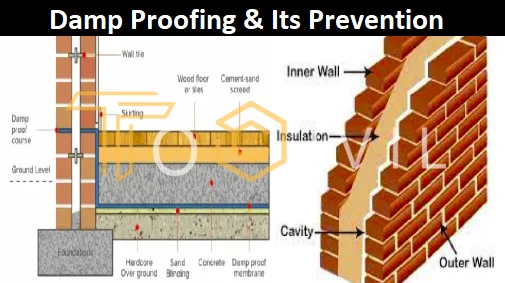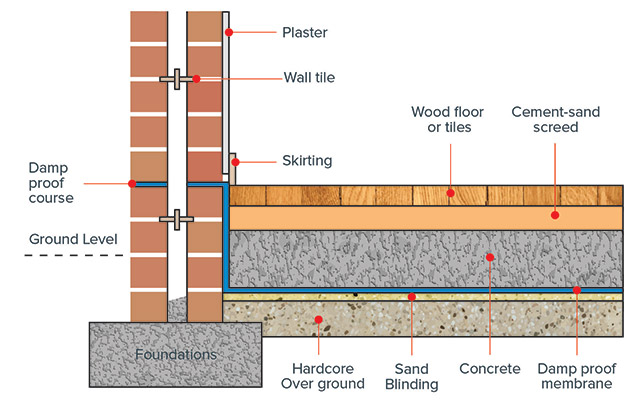Common signs you need damp proofing newcastle services now
Wiki Article
Exploring the Various Techniques and Solutions for Effective Damp Proofing
Moisture in structures presents significant challenges to both architectural stability and interior air top quality. Numerous methods and remedies have actually arised to combat this pervasive problem. From traditional damp-proof membrane layers to ingenious chemical therapies, each technique uses one-of-a-kind advantages. Understanding these alternatives is crucial for efficient wetness control. Nonetheless, selecting the appropriate service relies on certain building problems and needs, motivating more expedition into one of the most effective moist proofing strategies available.Understanding the Sources Of Wetness
Wetness can arise from numerous resources, recognizing these reasons is vital for reliable removal. Commonly, dampness stems from 3 primary sources: rising wet, penetrating damp, and condensation. Increasing moist takes place when groundwater travels upwards with permeable products, such as block or rock, commonly due to a lack of an efficient barrier (damp proofing newcastle). Permeating moist is usually triggered by external aspects, consisting of roofing system leaks, damaged seamless gutters, or damaged wall surfaces, permitting water to penetrate a property. Condensation, on the other hand, arises from excess wetness in the air, commonly exacerbated by poor air flow and temperature level distinctions, bring about water droplets basing on surfaces. Identifying these underlying issues is crucial, as each kind of dampness requires a customized method for remediation. Appropriate assessment aids in establishing the most effective solutions, eventually securing the structural stability of a building and enhancing interior air qualityStandard Damp-Proof Membranes

Chemical Damp-Proofing Solutions
Chemical damp-proofing services supply an ingenious method to avoid wetness intrusion in buildings. These methods usually include the application of fluid chemicals that permeate masonry and develop an obstacle versus rising damp. Commonly used chemicals include silanes, siloxanes, and other water-repellent agents that respond with surface area products to produce a hydrophobic layer.The application process usually requires exploration holes into the wall surfaces, infusing the chemical remedy, and allowing it to heal. This technique is especially helpful for older frameworks where conventional damp-proof membrane layers may be unwise. Chemical damp-proofing can be much less turbulent and much more economical than substantial remodelling projects.While efficient, these options depend on appropriate application and environmental conditions for peak efficiency. damp specialist newcastle. Routine upkeep and surveillance are vital to assure the durability of the damp-proofing treatment. Generally, chemical damp-proofing stands for a functional option for securing buildings against moisture-related damageCavity Wall Surface Building Methods
Tooth cavity wall surface building and construction strategies provide various benefits, particularly in moisture control and energy effectiveness. By incorporating an air space in between 2 layers of stonework, these wall surfaces properly reduce water access while enhancing insulation. This combination not just secures frameworks from dampness however additionally adds to minimized energy intake.Benefits of Cavity Walls
When thinking about effective damp proofing methods, the advantages of dental caries walls attract attention prominently. Dental caries walls contain 2 separate layers, creating an air space that successfully lowers wetness penetration. This style lessens the threat of dampness, as the outer wall surface acts as an obstacle against rainfall and water ingress. Furthermore, dental caries wall surfaces boost thermal insulation, which adds to energy effectiveness by minimizing heat loss. They also offer audio insulation, helping to produce a quieter interior atmosphere. The air space enables for ventilation, which helps in wetness control and minimizes the likelihood of mold growth. These advantages not just boost the general convenience of a building but additionally add to its long life and structural integrity.Dampness Control Approaches
Reliable moisture control strategies are vital in cavity wall surface building to assure long-lasting protection against moisture. One primary approach involves the consolidation of weep holes, which promote water drain from the tooth cavity, stopping accumulation. In addition, using breathable membranes can help manage moisture degrees while permitting caught vapor to run away. Proper positioning of insulation is likewise important, as it must not block drainage paths. Furthermore, making sure that the outer leaves of the cavity wall are created with water-resistant materials improves general toughness. Regular maintenance checks are crucial to identify any kind of blockages website or damages early, protecting the framework's honesty. Ultimately, a mix of these strategies forms a durable defense against dampness invasion in tooth cavity walls.
Insulation and Energy Performance
Insulation plays an important duty in improving power effectiveness within dental caries wall surface building. By integrating shielding materials, these wall surfaces produce a thermal obstacle that reduces warmth loss and minimizes energy usage. Efficient insulation not only helps preserve a steady interior temperature but also alleviates the threat of wetness, as it avoids condensation within the wall surface tooth cavity. Various methods, such as making use of rigid foam boards or mineral wool, can be utilized to achieve perfect insulation efficiency. In addition, proper installation is necessary to guarantee that spaces and voids are lessened, which can otherwise jeopardize power effectiveness. Inevitably, a well-insulated tooth cavity wall adds considerably to overall sustainability and reduces heating and air conditioning expenses for homeowners.Exterior Damp Proofing Approaches
Outside moist proofing techniques are important for protecting frameworks from moisture seepage. 2 efficient methods consist of the application of water-proof membrane layers and the setup of French drains. These remedies aid reduce water buildup and protect the honesty of buildings.Waterproof Membrane Application
While various techniques exist for avoiding moisture ingress, the application of water-proof membrane layers continues to be a highly reliable outside wet proofing method. These membranes are generally made from products such as polyethylene, rubber, or modified bitumen, giving a robust obstacle versus water penetration. The installment process entails applying the membrane layer to the outside surface areas of walls or structures, ensuring full insurance coverage to stop leakages. Proper bond and securing at joints are critical to optimizing efficiency. Water-proof membranes can be applied in different kinds, including fluid coatings and sheet membranes, allowing for flexibility based on the particular requirements of the framework. This approach not only secures buildings from dampness yet likewise enhances their durability and structural stability.French Drain Setup
One effective approach for taking care of groundwater and avoiding dampness build-up around a building's foundation is the installation of a French drain. This water drainage system contains a trench filled up with crushed rock and a perforated pipe that reroutes surface water away from the structure. Appropriate installment requires careful planning, ensuring that the drainpipe slopes away from the framework to assist in suitable water flow. Furthermore, the place of the drain is crucial; it needs to be placed in locations susceptible to pooling or excess wetness. Regular maintenance, including clearing up particles from the crushed rock and ensuring the pipe remains unobstructed, is important for lasting efficiency. Inevitably, a well-installed French drainpipe can significantly reduce the threat of water-related concerns in foundations and cellars.Inside Waterproofing Techniques
Inside waterproofing strategies are vital for safeguarding a building's inside from wetness seepage and possible water damages. These strategies typically entail the application of customized products and strategies designed to produce a wetness barrier within the structure. One common technique is the use of water resistant finishes or sealers on walls and floors, which stop wetness from passing through surfaces.Additionally, mounting indoor water drainage systems, such as sump pumps, can efficiently handle water accumulation in basements and creep rooms. Another technique involves the use of vapor obstacles, which are mounted to inhibit wetness motion from the ground right into living spaces.Moreover, dealing with any fractures or gaps in wall surfaces or structures with ideal sealants assures a detailed protection against water breach. By executing these indoor waterproofing techniques, homeowner can considerably minimize the danger of mold and mildew development, architectural damage, and various other moisture-related problems. Proper implementation of these strategies is vital for long-lasting security and structure honesty.Normal Upkeep and Assessment Practices
Normal upkeep and examination methods are crucial for guaranteeing the long-lasting performance of wet proofing options in any kind of structure. Routine checks allow residential property owners to determine very early indicators of wetness invasion, such as peeling off paint, mold and mildew growth, and moldy smells. These indications can indicate underlying concerns that require instant attention.Inspections ought to be conducted at the very least annually, concentrating on at risk locations like basements, creep rooms, and exterior walls. Throughout these analyses, homeowner must take a look at sealants, drain systems, and ventilation to confirm they operate correctly.Additionally, maintaining downspouts and gutters is vital, as stopped up systems can lead to water build-up near the foundation. Executing a routine upkeep timetable, in addition to timely repair work, can considerably extend the life-span of wet proofing measures and secure the architectural honesty of the building. Positive actions inevitably contribute to the overall health and security of the living environment.Regularly Asked Inquiries
How Much Time Does Damp Proofing Usually Last?
The period of moist proofing performance varies, commonly lasting in between 20 to half a century. Factors such as application quality, ecological problems, and upkeep techniques significantly influence the long life of the wet proofing treatment.
Can I Damp Proof My Home Myself?
The private pondered the expediency of DIY damp proofing. With proper study and the ideal products, it is feasible. They likewise identified the value of specialist guidance to ensure resilient performance and protect against future issues.What Are the Indications of Inefficient Damp Proofing?
Signs of inefficient wet proofing consist of consistent moldy odors, noticeable mold and mildew growth, peeling off paint, damp spots on walls, and wood decay - mould removal newcastle. House owners need to deal with these problems without delay to avoid further damage and wellness worriesDoes Damp Proofing Affect Indoor Air Quality?

Just How Much Does Expert Damp Proofing Expense?
Professional moist proofing prices differ substantially, generally ranging from $1,000 to $5,000 depending upon the residential property's dimension, the degree of the wet issue, and selected approaches. Each scenario calls for a customized analysis for accurate pricing. Typically, wetness originates from three main sources: increasing wet, permeating moist, and condensation. When considering reliable damp proofing approaches, the benefits of dental caries wall surfaces stand out prominently. Outside damp proofing techniques are necessary for securing structures from dampness infiltration. While different techniques exist for protecting against wetness ingress, the application of water resistant membrane layers remains an extremely effective outside damp proofing technique. Signs of ineffective moist proofing consist of relentless mildewy smells, visible mold development, peeling paint, damp patches on wall surfaces, and wood degeneration.Report this wiki page